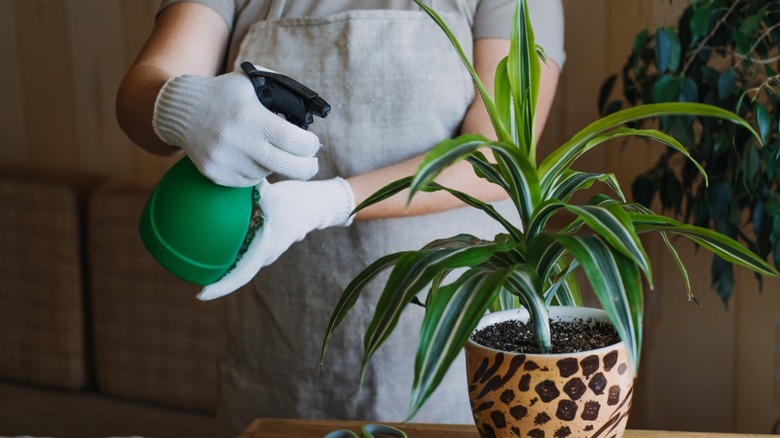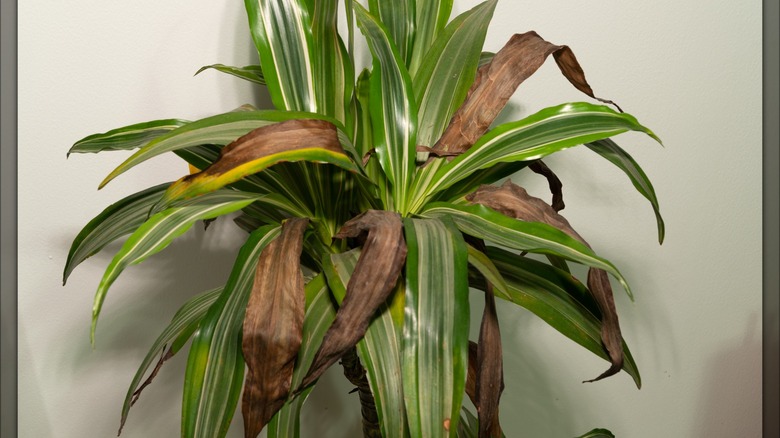The Real Reason Your Corn Plant Is Dying (& How To Revive It)
Is your maize in a daze? Is your corn looking forlorn? It might indeed surprise you to find that it's not uncommon to be a corn-killer. But do not despair, for there's hope for you yet! We'll show you what to do to put the pop back into your corn plant in no time. One of the biggest reasons corn plants die is over-watering, as they don't need much and are prone to root rot. Although you'll have to remove a large portion of the plant, we'll explain exactly how to save your corn plant from root rot if it becomes necessary.
All corniness aside, we're talking about the houseplant, not the plant that grows corn. Its official name is the Dracaena fragrans plant. There are a few other common reasons this plant could start looking unhealthy, and we'll go over them, too, as well as the cures. The amazing thing about the corn plant is its resiliency; it can tolerate being neglected or forgotten for quite some time. As long as you catch it before it's completely dead, most times, you can rejuvenate it with just a little TLC.
Other reasons your corn plant is dying
Corn plants cannot tolerate drought, either. When temperatures are very hot and there's not enough moisture in the soil, these are considered drought conditions, and the plants can die. It also needs a fairly consistent 40-50% humidity. You can add a humidifier to the room your corn plant is in if needed. Dry, brown leaves and/or tips of leaves may be present. If you notice brown spots with a yellow ring around them, this is caused by sunburn. Move the plant out of the direct sunlight if this happens.
It's also important to pay attention to lower temperatures, especially if you live in a climate that frequently gets below 55 degrees Fahrenheit. They won't thrive in cooler temperatures, where it's often in the 50s, unless kept indoors, where they can be kept at their ideal temperature of between 65 and 75 degrees Fahrenheit.
It could also be a nutrient deficiency if the leaves begin yellowing or become pale and the plant gets weak. Try giving your corn plant a healthy dose of liquid fertilizer if you haven't fed it recently. Once a month, from about April through October, is usually ideal. You don't need to use fertilizer over the winter. However, nutrient deficiency in corn plants is rare, and it's actually easier to over-fertilize than not giving them enough fertilizer.
How to save your corn plant from root rot
Unfortunately, corn plants are extremely vulnerable to disease, and one of those is root rot. Over watering exacerbates this condition, so if you notice the leaves and stems looking droopy and wilted, this is an early sign. Also if you see any yellowing or notice a bad smell near the lower part of the stem, you likely have root rot. Pests like fungus gnats and aphids will attack corn plants with root rot, as well. To save your plant you will need to sterilize a pair of gardening shears, and get a new planter and new potting mix.
Remove the plant and root ball from the old container. Now take the sterilized shears and cut all the dead roots off the root ball. Rinse the soil off the remaining healthy roots. You will then need to re-sterilize the shears before removing all dead or damaged leaves and foliage. Make sure you have the appropriate size plant and planter for the new smaller root ball. Get your new planter and transplant it with the new potting mix. Water it very slowly and be sure it's draining well. Be sure to throw everything away that was contaminated and sterilize tools used. Check the plant in a couple of days and watch closely to make sure it takes. Your corn should be popping green again in no time!


